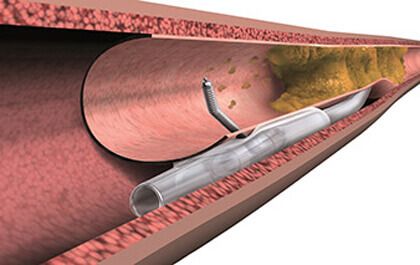Dyspnea is one of the most challenging symptoms as regards its assessment and treatment in patients with coronary disease, since it may stem from both cardiac and non-cardiac causes. Patients in whom dyspnea is the sole symptom of coronary disease are at a higher risk of not receiving adequate treatment, and their short- and long-term…
Important Study Suggests that Rotational Atherectomy Is Feasible with Transradial Access
Rotational atherectomy is a very important tool in the treatment of heavily calcified and non-dilatable lesions. Historically, transfemoral access has been the gold standard due to a perceived need for large-bore guidewire catheters in order to use spheroids for proper debulking. Nowadays, rotational atherectomy has evolved towards a technique that aims to modify plaque for…
What Is the Long-Term Outcome of Lesions Deferred Using FFR/iFR?
The presence of inducible ischemia is an essential prerequisite to obtain clinical benefits from revascularization through angioplasty. In that sense, the measurement of fractional flow reserve (FFR) is the gold standard as regards invasive methods assessing the functional significance of epicardial artery stenosis. As opposed to FFR, the measurement of the instantaneous wave-free ratio (iFR)…
The Use of Intravascular Imaging to Guide PCI Reduces Cardiovascular Death Risk, Compared to Angiography
Intravascular imaging, which includes ultrasound intravascular (IVUS) and optical coherence tomography (OCT), shows live details that better characterize post stenting plaque, anatomy and outcomes. The already familiar limitations of the angiography has lead us to think that IVUS and OCT could improve clinical outcomes; however, we should still find the evidence to support this claim. To shed some…
Quality of Life Between Surgery and Angioplasty for the Treatment of Left Main Disease
In recent years, angioplasty with drug-eluting stents (DES) has emerged as an alternative to myocardial revascularization surgery in patients with left main coronary artery disease. Both European and American guidelines offer a Class IIa recommendation for left main coronary artery (LMCA) angioplasty in selected patients. The EXCEL (Evaluation of Xience Versus Coronary Artery Bypass Surgery for…
Coronary Angioplasty Is a Valid Alternative for Left Main Coronary Artery Disease
Courtesy of Dr. Carlos Fava. Severe left main coronary artery (LMCA) lesions have a bad prognosis in coronary disease. In that scenario, current guidelines recommend surgery as the treatment of choice. However, due to the current development of second-generation drug-eluting stents (DES) and greater operator expertise, left main coronary artery angioplasty appears as a valid alternative…
Aspirin During Noncardiac Surgery: Only in Patients with Prior Angioplasty
A new analysis from the POISE-2 study suggests that aspirin should not be withheld prior to noncardiac surgery in patients with a history of coronary angioplasty, even if their coronary procedure occurred several years earlier. Patients with a history of coronary angioplasty who need cardiac surgery are more likely to benefit from continued aspirin therapy,…
Complex PCI: DAPT defining factor?
Courtesy of Dr. Alejandro Lakowsky, MTSAC. The Journal of the American College of Cardiology (JACC) has recently published a study on the role of coronary anatomy and PCI technical difficulty in the cost benefit ratio of prolonged vs. short post procedural DAPT. This study was carried out by Robert Yeh, Laura Mauri and the DAPT trial…
Patients and Healthcare Providers Benefit from Less Symptoms and Lower Costs with FFR
Previous studies in which revascularization was guided by angiography alone found that coronary angioplasty does not improve outcomes compared with optimal medical treatment in patients with chronic stable angina. The FAME 2 trial (Fractional Flow Reserve Versus Angiography for Multivessel Evaluation) compared angioplasty guided by fractional flow reserve (FFR) with optimal medical treatment, arriving to…
Angioplasty Complexity May Define the Duration of Dual Antiplatelet Therapy
The DAPT study concluded that continued thienopyridine plus aspirin beyond a year after coronary angioplasty is associated with a decrease in the rate of stent thrombosis and major cardiovascular events. In contrast, there is a significant increase in moderate to severe bleeding when compared with continued aspirin alone. Based on the outcomes of this and…









